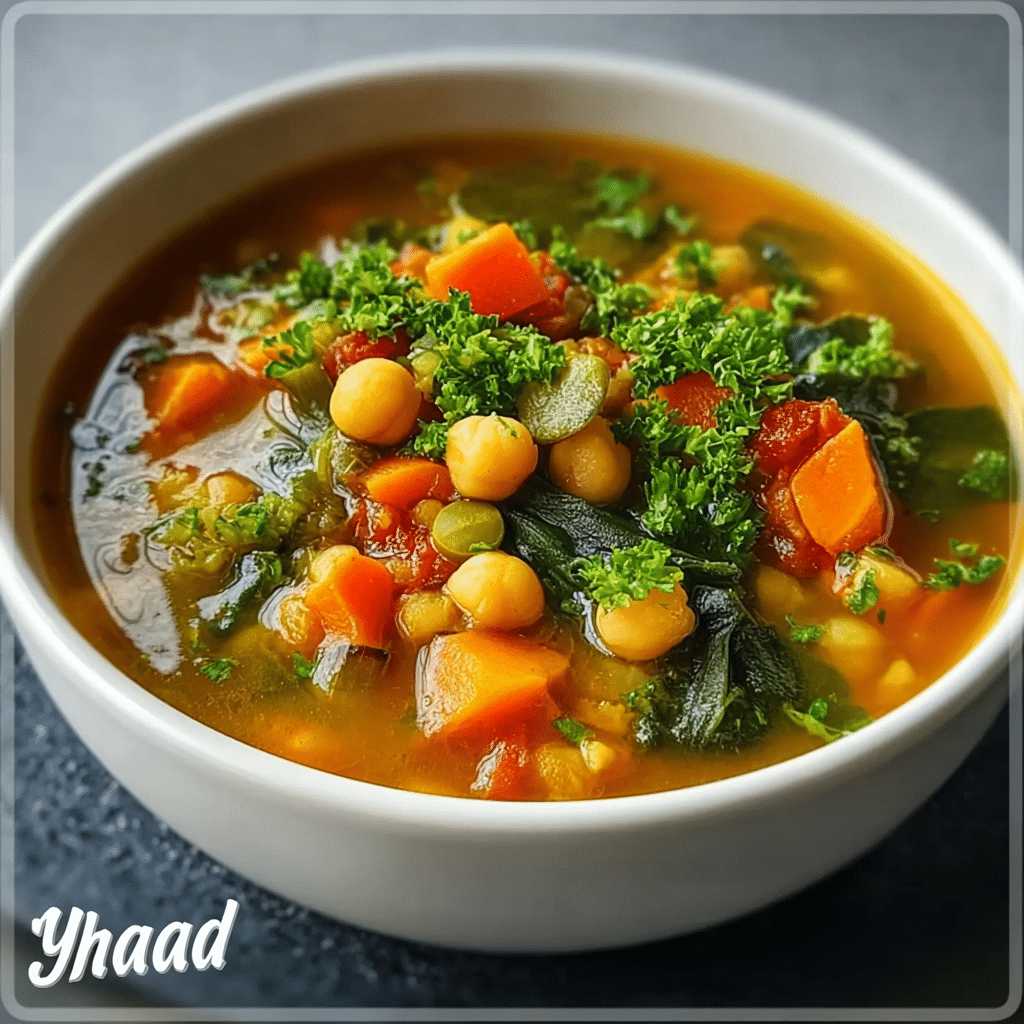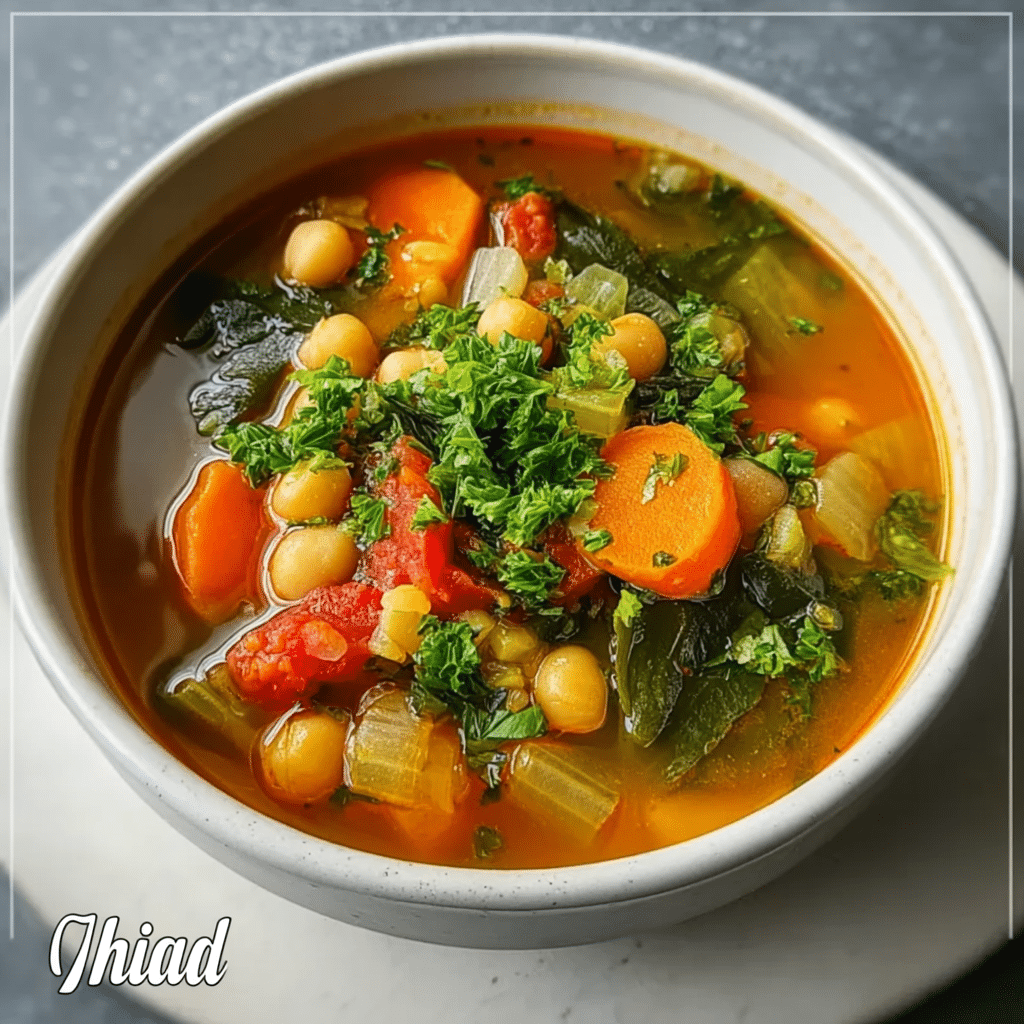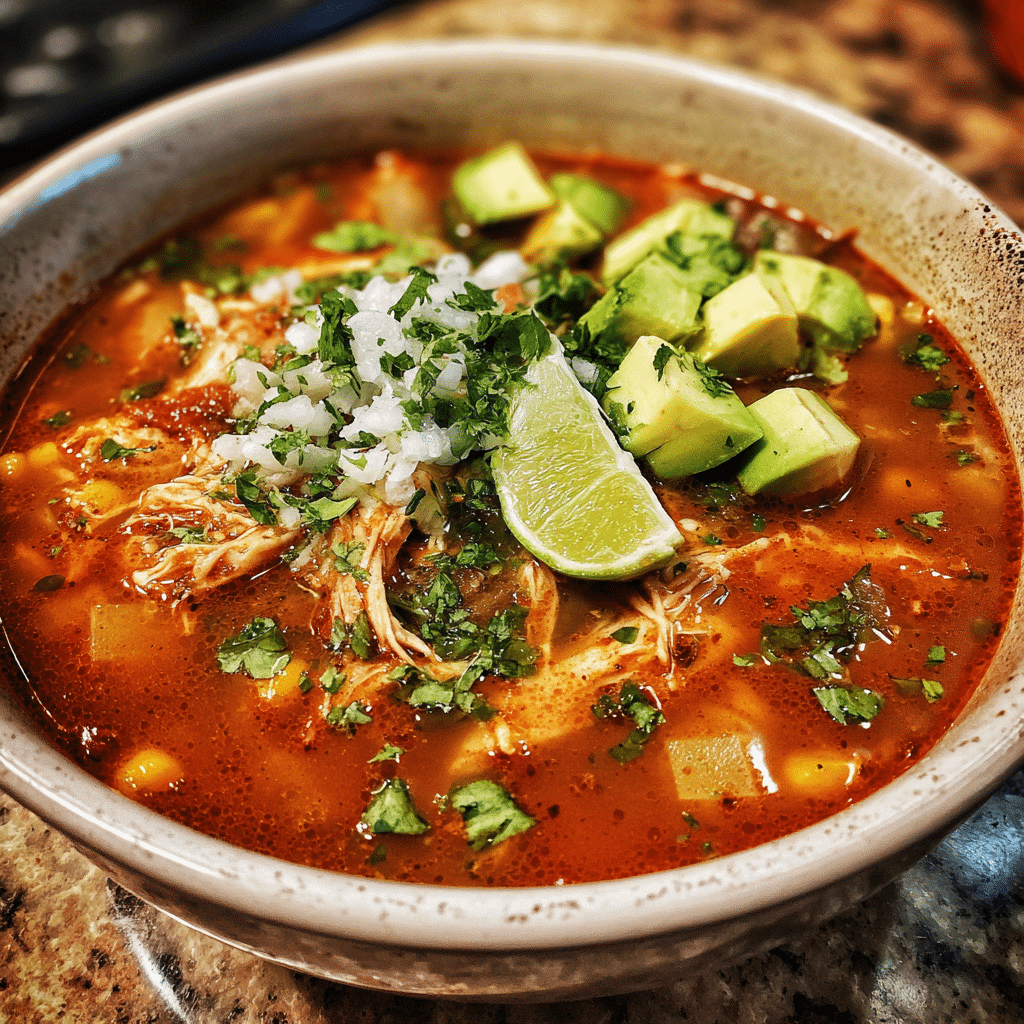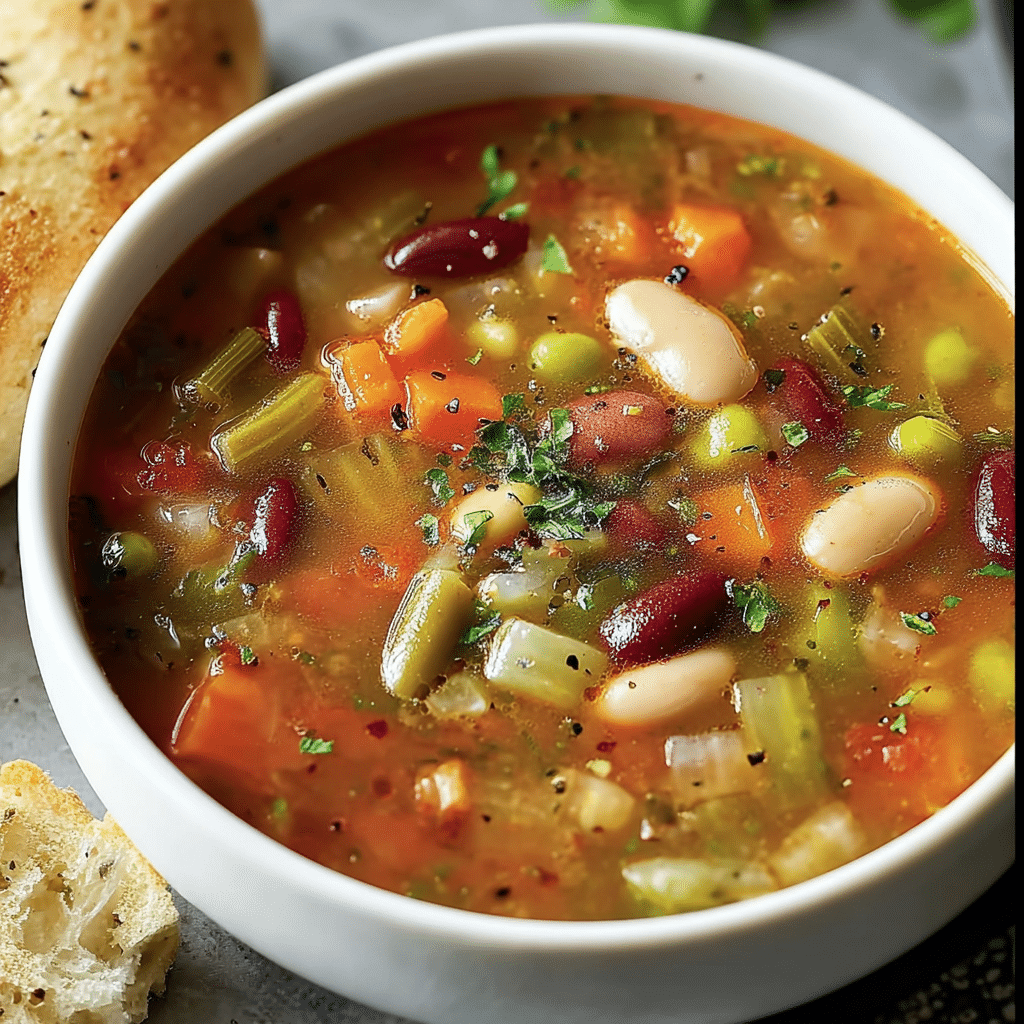Finding delicious ways to boost your protein intake without relying on meat can be challenging. However, this high protein vegetable soup recipe changes everything by combining nutrient-dense legumes with fresh vegetables in a satisfying bowl. Moreover, this plant-based powerhouse delivers over 15 grams of protein per serving while maintaining incredible flavor.
Additionally, this soup proves that healthy eating doesn’t mean sacrificing taste. Furthermore, it’s perfect for vegans, vegetarians, and anyone looking to incorporate more plant-based meals into their diet. The combination of lentils, chickpeas, and fresh vegetables creates a complete amino acid profile that rivals any meat-based dish.
Print
High Protein Vegetable Soup Recipe: The Ultimate Nutritious Plant-Based Delight
- Total Time: 45 minutes
- Yield: undefined
Description
This High Protein Vegetable Soup is a hearty, nutrient-packed vegan dish made with lentils, chickpeas, and a medley of fresh vegetables. Perfect for boosting protein intake while staying light, flavorful, and satisfying!
Ingredients
- 4 cups (1 liter) vegetable broth
- 2 cups mixed vegetables (fresh or frozen)
- 1 cup lentils, rinsed
- 1 cup chickpeas, drained and rinsed
- 2 cups fresh spinach, chopped
- 3 cloves garlic, minced
- 1 medium onion, diced
- 2 tbsp olive oil
- 1 tsp dried thyme
- 1 tsp dried oregano
- Salt, to taste
- Black pepper, to taste
- 1 tbsp lemon juice (optional)
Instructions
- Wash and chop the vegetables.
- In a large pot, heat olive oil over medium heat. Add onion and garlic; sauté for 3–4 minutes.
- Stir in the rinsed lentils and cook for 2 minutes.
- Pour in the vegetable broth, bring to a boil, then reduce heat and simmer for 15 minutes.
- Add mixed vegetables and chickpeas. Simmer for another 10–15 minutes.
- Stir in spinach, thyme, and oregano. Cook for 5 more minutes.
- Season with salt, pepper, and lemon juice if desired. Serve warm.
Notes
- Customize the vegetables based on what you have on hand.
- Can be prepared ahead and stored in the fridge for 4 days or freezer for up to 2 months.
- Add chili peppers or hot sauce for spice, or coconut milk for a creamy texture.
- Prep Time: 10 minutes
- Cook Time: 35 minutes
- Category: undefined
- Method: Simmering
- Cuisine: Vegan
Nutrition
- Serving Size: 1 bowl
- Calories: 280 kcal
- Sugar: 7 g
- Sodium: 720 mg
- Fat: 9 g
- Saturated Fat: 1.5 g
- Unsaturated Fat: 7 g
- Trans Fat: 0 g
- Carbohydrates: 38 g
- Fiber: 12 g
- Protein: 15 g
- Cholesterol: 0 mg
Keywords: high protein soup, vegan soup, lentil vegetable soup, chickpea spinach soup, healthy vegan recipes
Why You’ll Love This High Protein Vegetable Soup
This high protein vegetable soup recipe offers countless benefits that make it a standout choice for health-conscious individuals. Moreover, it addresses multiple dietary needs while delivering exceptional taste and nutrition.
• It’s incredibly protein-rich: Contains over 15 grams of complete protein per serving • It’s budget-friendly: Uses affordable pantry staples that won’t break the bank • It’s meal prep perfect: Tastes even better after flavors meld overnight • It’s highly customizable: Adapt vegetables and seasonings to your preferences • It’s nutrient-dense: Packed with vitamins, minerals, and fiber • It’s quick to prepare: Ready in just 45 minutes from start to finish • It’s freezer-friendly: Makes excellent batches for future meals
Furthermore, this soup supports weight management goals while keeping you satisfied. Additionally, the fiber content promotes digestive health and sustained energy levels. Moreover, the variety of vegetables ensures you’re getting diverse micronutrients in every bowl.
Understanding Plant-Based Protein in Vegetable Soup
Many people worry about getting adequate protein from plant-based sources. However, this high protein vegetable soup demonstrates how legumes can provide complete nutrition. Specifically, combining lentils and chickpeas creates a complete amino acid profile.
Additionally, plant-based proteins offer unique advantages over animal proteins. For instance, they come packaged with fiber, antioxidants, and phytonutrients. Moreover, legumes provide sustained energy without the saturated fat found in many animal proteins.
Furthermore, this soup proves that protein doesn’t have to be expensive or complicated. Instead, simple ingredients like lentils and chickpeas deliver exceptional nutritional value at a fraction of the cost of meat.
Essential Ingredients for Perfect High Protein Vegetable Soup
Creating the ultimate high protein vegetable soup requires carefully selected ingredients that work synergistically. Moreover, each component contributes specific nutrients and flavors that enhance the overall experience.
Protein Powerhouse Ingredients
The protein foundation makes this vegetable soup truly exceptional:
• Lentils (1 cup, rinsed): Provide 18 grams of protein plus iron and folate • Chickpeas (1 cup, drained): Add 15 grams of protein and satisfying texture • Fresh spinach (2 cups, chopped): Contains 5 grams of protein plus iron and vitamins
Additionally, these legumes provide different textures and flavors. Furthermore, they cook at similar rates, ensuring even doneness throughout the soup.
Flavor Foundation Components
The aromatic base creates depth and complexity in your high protein vegetable soup:
• Vegetable broth (4 cups): Forms the flavorful liquid foundation • Medium onion (1, diced): Provides sweet, aromatic base notes • Garlic cloves (3, minced): Adds pungent depth and health benefits • Olive oil (2 tablespoons): Facilitates nutrient absorption and flavor development
Moreover, quality vegetable broth significantly impacts the final taste. Therefore, choose low-sodium options for better seasoning control.
Vegetable Medley Options
The mixed vegetables add color, nutrition, and textural variety:
• Carrots: Provide beta-carotene and natural sweetness • Celery: Adds crunch and subtle flavor complexity • Bell peppers: Contribute vitamin C and vibrant color • Zucchini: Offers mild flavor and additional nutrients • Green beans: Provide texture and fresh garden taste
Additionally, frozen vegetables work perfectly in this recipe. Furthermore, they’re often more nutritious than fresh vegetables that have traveled long distances.
Seasoning and Enhancement Ingredients
The herbs and seasonings elevate this high protein vegetable soup:
• Dried thyme (1 teaspoon): Adds earthy, aromatic notes • Dried oregano (1 teaspoon): Provides Mediterranean flavor depth • Salt and black pepper: Essential for balancing all flavors • Fresh lemon juice (1 tablespoon): Brightens and enhances other flavors
However, adjust seasonings gradually to avoid oversalting. Additionally, fresh herbs can substitute for dried herbs using a 3:1 ratio.
Step-by-Step High Protein Vegetable Soup Preparation
Creating perfect high protein vegetable soup requires proper technique and timing. Moreover, following these detailed steps ensures consistent, delicious results every time.
Step 1: Preparing Your Ingredients
Proper preparation sets the foundation for exceptional high protein vegetable soup:
- Rinse lentils thoroughly under cold water until water runs clear
- Drain and rinse canned chickpeas to remove excess sodium
- Dice onion into uniform pieces for even cooking
- Mince garlic cloves finely for optimal flavor distribution
- Chop fresh spinach, removing thick stems
- Prepare mixed vegetables according to package directions
Additionally, having all ingredients prepped before cooking streamlines the process. Furthermore, uniform vegetable sizes ensure even cooking throughout the soup.
Step 2: Building the Aromatic Base
The flavor foundation requires careful attention to develop properly:
- Heat olive oil in a large, heavy-bottomed pot over medium heat
- Add diced onion and cook for 3-4 minutes until translucent
- Stir in minced garlic and cook for additional 30 seconds
- Avoid burning garlic, which creates bitter flavors
- The mixture should smell fragrant and inviting
Moreover, proper heat control prevents burning while developing flavors. Additionally, stirring frequently ensures even cooking and prevents sticking.
Step 3: Incorporating the Protein Elements
Adding legumes correctly ensures optimal texture in your high protein vegetable soup:
- Add rinsed lentils to the aromatic base
- Stir continuously for 2 minutes to toast lightly
- This step enhances lentil flavor and prevents mushiness
- Listen for gentle sizzling sounds indicating proper heat
- Avoid stirring too vigorously to prevent breaking lentils
Furthermore, toasting lentils briefly improves their nutty flavor. However, watch carefully to prevent burning or sticking.
Step 4: Adding Liquid and Initial Cooking
Proper liquid incorporation creates the perfect soup consistency:
- Pour vegetable broth slowly into the pot
- Scrape bottom to release any browned bits
- Bring mixture to a rolling boil over high heat
- Reduce heat to maintain gentle simmer
- Cover partially and cook for 15 minutes
Additionally, scraping the pot bottom incorporates flavorful browned bits. Moreover, maintaining gentle simmer prevents lentils from breaking apart.
Step 5: Adding Vegetables and Chickpeas
Timing vegetable additions ensures perfect texture in your high protein vegetable soup:
- Add prepared mixed vegetables to the simmering soup
- Stir in drained chickpeas gently
- Return to gentle simmer
- Cook for 10-15 minutes until vegetables are tender
- Test vegetables with fork for desired doneness
However, avoid overcooking vegetables, which destroys nutrients and creates mushy texture. Instead, aim for tender-crisp consistency.
Step 6: Final Additions and Seasoning
The finishing touches complete your high protein vegetable soup:
- Stir in chopped fresh spinach gradually
- Add dried thyme and oregano
- Season with salt and black pepper to taste
- Cook for final 5 minutes until spinach wilts
- Add lemon juice just before serving
Furthermore, spinach wilts quickly, so avoid overcooking. Additionally, lemon juice maintains its brightness when added at the end.

Expert Tips for the Best High Protein Vegetable Soup
Creating restaurant-quality high protein vegetable soup requires insider knowledge. Moreover, these professional techniques elevate your soup from good to extraordinary.
Legume Cooking Mastery
Achieving perfect legume texture requires specific approaches:
• Rinse thoroughly: Removes debris and reduces cooking foam • Toast briefly: Enhances nutty flavors without oil • Simmer gently: Prevents breaking and maintains shape • Test doneness regularly: Prevents overcooking and mushiness • Add salt late: Early salting can toughen legume skins
Additionally, slightly undercooked legumes continue cooking in hot broth. Furthermore, different legume varieties may require adjusted cooking times.
Vegetable Optimization Techniques
Maximizing vegetable contribution requires strategic timing:
• Cut uniformly: Ensures even cooking throughout • Add by cooking time: Harder vegetables first, tender ones last • Maintain color: Avoid overcooking to preserve nutrients • Layer flavors: Sauté aromatics before adding liquids • Balance textures: Combine soft and firm vegetables
Moreover, frozen vegetables often cook faster than fresh ones. Therefore, adjust timing accordingly to prevent overcooking.
Broth Enhancement Methods
Elevating your vegetable broth creates superior high protein vegetable soup:
• Choose quality broth: Impacts overall flavor significantly • Build layers: Add seasonings at different cooking stages • Taste frequently: Adjust flavors throughout cooking process • Control salt: Use low-sodium broth for better control • Add acid last: Preserves bright, fresh flavors
Additionally, homemade vegetable broth creates superior results. However, quality store-bought options work perfectly for convenience.
Creative Variations for High Protein Vegetable Soup
This high protein vegetable soup recipe serves as an excellent foundation for countless variations. Moreover, customization allows adaptation to dietary preferences and seasonal availability.
International Flavor Profiles
Transform your soup with global seasonings:
Mediterranean Style: • Add sun-dried tomatoes and fresh basil • Include kalamata olives and artichoke hearts • Season with rosemary and bay leaves • Finish with fresh parsley and lemon zest
Mexican-Inspired Version: • Include corn kernels and diced jalapeños • Add cumin, chili powder, and paprika • Finish with fresh cilantro and lime juice • Serve with avocado slices and hot sauce
Asian-Fusion Approach: • Add ginger, soy sauce, and sesame oil • Include bok choy and mushrooms • Season with rice vinegar and sriracha • Garnish with green onions and sesame seeds
Furthermore, each variation maintains the high protein content while offering exciting new flavors. Additionally, these modifications use easily available ingredients.
Seasonal Vegetable Adaptations
Customize your high protein vegetable soup based on seasonal availability:
Spring Vegetables: • Include asparagus spears and peas • Add fresh herbs like dill and chives • Use baby spinach and tender greens • Incorporate radishes for peppery bite
Summer Bounty: • Feature zucchini, yellow squash, and tomatoes • Add fresh corn kernels and bell peppers • Include fresh basil and oregano • Use cucumber for cooling effect
Fall Harvest: • Incorporate butternut squash and sweet potatoes • Add cauliflower and Brussels sprouts • Season with sage and thyme • Include apples for subtle sweetness
Winter Comfort: • Use hearty root vegetables like parsnips • Add cabbage and kale for substance • Include warming spices like ginger • Feature storage vegetables like turnips
Moreover, seasonal vegetables often cost less and taste better. Additionally, they provide variety throughout the year.
Common High Protein Vegetable Soup Mistakes to Avoid
Even experienced cooks can encounter issues with high protein vegetable soup preparation. However, recognizing these common pitfalls ensures consistent success.
Legume Preparation Errors
Several mistakes can affect legume quality:
• Skipping the rinse: Leaves debris and excess starch • Adding salt too early: Can toughen legume skins • Overcooking: Creates mushy, unappetizing texture • Using old legumes: Results in uneven cooking • Insufficient liquid: Causes burning and sticking
Furthermore, checking legume expiration dates prevents cooking frustration. Additionally, storing legumes properly maintains their quality longer.
Vegetable Timing Issues
Proper timing ensures optimal vegetable texture:
• Adding all vegetables simultaneously: Causes uneven cooking • Overcooking tender vegetables: Destroys nutrients and texture • Undercooking root vegetables: Creates unpleasant crunch • Forgetting to taste: Results in under-seasoned soup • Adding acid too early: Can prevent proper vegetable softening
Moreover, understanding individual vegetable cooking times improves results significantly. Additionally, tasting throughout cooking allows proper seasoning adjustments.
Seasoning and Flavor Problems
Balanced seasoning requires attention throughout cooking:
• Over-salting early: Concentrates as liquid reduces • Under-seasoning: Creates bland, uninteresting soup • Adding herbs too early: Loses aromatic compounds • Skipping acid: Misses brightness and balance • Ignoring texture contrast: Creates monotonous eating experience
Additionally, different salt types have varying intensities. Therefore, taste frequently when switching salt varieties.
Nutritional Benefits of High Protein Vegetable Soup
This high protein vegetable soup recipe delivers exceptional nutritional value in every serving. Furthermore, it provides complete nutrition while supporting various health goals.
Complete Protein Profile
The legume combination creates nutritionally complete protein:
Lentils Provide: • 18 grams protein per cup • Essential amino acids leucine and lysine • High folate content for cellular health • Iron for oxygen transport • Fiber for digestive health
Chickpeas Contribute: • 15 grams protein per cup • Complementary amino acids to lentils • Magnesium for muscle function • Phosphorus for bone health • B vitamins for energy metabolism
Moreover, this combination provides all nine essential amino acids. Additionally, plant proteins are easier to digest than many animal proteins.
Micronutrient Powerhouse
The vegetable variety ensures comprehensive nutrition:
Spinach Benefits: • High in iron and folate • Rich in vitamins A, C, and K • Contains antioxidants lutein and zeaxanthin • Provides nitrates for cardiovascular health
Mixed Vegetables Supply: • Beta-carotene from orange vegetables • Vitamin C from peppers and tomatoes • Potassium from various sources • Antioxidants from colorful varieties
Furthermore, eating diverse vegetables provides synergistic nutritional benefits. Additionally, cooking enhances some nutrient absorption.
Health Benefits Overview
Regular consumption of high protein vegetable soup supports multiple health aspects:
• Weight management: High fiber and protein promote satiety • Heart health: Legumes help lower cholesterol levels • Blood sugar control: Fiber slows glucose absorption • Digestive health: Promotes beneficial gut bacteria • Inflammation reduction: Antioxidants combat oxidative stress
Moreover, plant-based proteins support environmental sustainability. Additionally, legumes improve soil health through nitrogen fixation.
Serving Suggestions for High Protein Vegetable Soup
Proper presentation and accompaniments enhance the high protein vegetable soup experience. Moreover, thoughtful pairings create satisfying, complete meals.
Traditional Accompaniments
Classic sides complement this nutritious soup perfectly:
• Crusty whole grain bread: Provides additional fiber and satisfaction • Fresh herb garnishes: Brighten flavors and add visual appeal • Lemon wedges: Allow individual acidity adjustment • Nutritional yeast: Adds cheesy flavor and B vitamins • Hemp seeds: Boost protein and healthy fats
Additionally, toasted seeds and nuts provide textural contrast. Furthermore, fresh microgreens add elegant visual appeal.
Creative Serving Ideas
Modern presentations offer exciting variations:
• Grain bowls: Serve over quinoa or brown rice • Bread bowls: Use hollowed sourdough for rustic presentation • Mason jar meals: Perfect for grab-and-go convenience • Soup shooters: Elegant appetizer portions • Thermos lunches: Ideal for work or school meals
Moreover, serving temperature affects flavor perception. Therefore, serve hot for maximum enjoyment and comfort.
Portion Control and Satisfaction
Understanding proper portions ensures satisfaction without overeating:
• Standard serving: 1.5 cups provides complete nutrition • Light meal: 1 cup with bread creates satisfying lunch • Hearty dinner: 2 cups with grain makes filling meal • Appetizer: 1/2 cup portions start meals perfectly • Snack size: Small portions satisfy between meals
Furthermore, the high protein content promotes longer satiety. Additionally, fiber helps regulate hunger hormones naturally.
Storage and Meal Prep Tips for High Protein Vegetable Soup
Proper storage maximizes your high protein vegetable soup investment. Moreover, this soup excels at meal prep and batch cooking strategies.
Refrigeration Guidelines
Follow these steps for safe soup storage:
- Cool soup completely before refrigerating
- Store in airtight containers within 2 hours
- Refrigerate for up to 5 days maximum
- Keep temperature at 40°F or below
- Label containers with date and contents
Furthermore, glass containers prevent staining and odor absorption. Additionally, shallow containers cool faster than deep ones.
Freezing Instructions
This high protein vegetable soup freezes excellently:
• Cool completely: Never freeze hot soup • Use freezer-safe containers: Leave expansion space • Freeze within 3 days: Don’t wait too long • Label clearly: Include date and reheating instructions • Use within 6 months: For optimal quality
However, note that some vegetables may soften slightly after freezing. Additionally, spinach may become more tender but remains nutritious.
Meal Prep Strategies
Maximize efficiency with smart meal prep approaches:
Weekly Batch Cooking:
- Make double recipe on weekends
- Portion into individual containers
- Refrigerate 3 days worth, freeze remainder
- Thaw overnight before reheating
- Add fresh herbs when serving
Ingredient Prep Method:
- Prep all vegetables in advance
- Store separately in refrigerator
- Cook soup fresh when desired
- Reduces cooking time to 25 minutes
- Maintains optimal vegetable texture
Moreover, cooked legumes can be prepared in advance. Furthermore, homemade vegetable broth can be frozen in portions.
Reheating Best Practices
Proper reheating maintains quality and safety:
Stovetop Method:
- Transfer to saucepan over medium-low heat
- Stir occasionally to prevent sticking
- Add broth if soup thickened during storage
- Heat until steaming throughout
- Adjust seasoning before serving
Microwave Method:
- Use microwave-safe bowl with cover
- Heat in 90-second intervals
- Stir between heating cycles
- Ensure even heating throughout
- Let stand before serving
Additionally, avoid reheating multiple times for food safety. Moreover, frozen soup should thaw overnight before reheating.
FAQs About High Protein Vegetable Soup
Q: How much protein does this high protein vegetable soup contain?
A: Each serving provides approximately 15-18 grams of complete protein. Specifically, the combination of lentils (9 grams), chickpeas (7 grams), and spinach (2 grams) creates this impressive total. Moreover, this protein is complete, meaning it contains all nine essential amino acids your body needs. Additionally, the protein is highly digestible and absorbed efficiently by your body.
Q: Can I use different legumes in this vegetable soup recipe?
A: Absolutely! This recipe adapts well to various legume combinations. For instance, you can substitute black beans, kidney beans, or white beans for chickpeas. Additionally, red lentils cook faster than green lentils, so adjust timing accordingly. Moreover, each legume brings unique flavors and nutritional profiles. Furthermore, mixing different legumes increases amino acid diversity.
Q: Is this high protein vegetable soup suitable for meal prep?
A: Yes, this soup is perfect for meal prep strategies. In fact, the flavors improve after sitting overnight in the refrigerator. Additionally, it stores well for up to 5 days refrigerated or 6 months frozen. Moreover, you can portion it into individual containers for grab-and-go convenience. Furthermore, it reheats beautifully without losing texture or flavor.
Q: Can I make this soup in a slow cooker or pressure cooker?
A: Both methods work excellently for this high protein vegetable soup. For slow cooker preparation, combine all ingredients except spinach and cook on low for 6-8 hours. Additionally, add spinach during the last 30 minutes to prevent overcooking. Moreover, pressure cooker versions cook in just 12 minutes on high pressure with natural release. Furthermore, both methods intensify flavors beautifully.
Q: How can I make this vegetable soup creamier without dairy?
A: Several plant-based options create creamy texture in high protein vegetable soup. First, blend 1-2 cups of the finished soup and stir back in for natural thickness. Additionally, add 1/2 cup coconut milk or cashew cream for richness. Moreover, pureed silken tofu creates protein-rich creaminess. Furthermore, nutritional yeast adds cheesy flavor while maintaining vegan status.
Q: What vegetables work best in high protein vegetable soup?
A: Choose vegetables with complementary cooking times and flavors. Specifically, root vegetables like carrots and potatoes provide substance and sweetness. Additionally, cruciferous vegetables like broccoli and cauliflower add nutrients and texture. Moreover, leafy greens like spinach and kale boost iron and vitamins. Furthermore, colorful vegetables ensure diverse antioxidants and visual appeal.
Q: Can children enjoy this high protein vegetable soup?
A: Yes, this soup is excellent for children’s nutrition needs. However, you might want to reduce strong seasonings and add familiar vegetables. Additionally, blending part of the soup creates smoother texture that children often prefer. Moreover, involving children in preparation increases their willingness to try new foods. Furthermore, the mild flavors appeal to developing palates.
Q: How do I prevent my legumes from becoming mushy?
A: Proper technique prevents mushy legumes in high protein vegetable soup. First, avoid overcooking by testing doneness regularly. Additionally, maintain gentle simmer rather than vigorous boiling. Moreover, add salt only after legumes have softened to prevent tough skins. Furthermore, slightly undercook legumes as they continue cooking in hot broth.
Conclusion
This high protein vegetable soup recipe proves that plant-based eating can be both nutritious and delicious. Moreover, it demonstrates how simple ingredients combine to create extraordinary results. The perfect balance of protein-rich legumes, vibrant vegetables, and aromatic seasonings makes every spoonful satisfying and nourishing.
Additionally, this soup addresses multiple dietary needs while remaining budget-friendly and accessible. Whether you’re following a vegan lifestyle, looking to increase protein intake, or simply wanting more vegetables in your diet, this recipe delivers exceptional value. Furthermore, its versatility allows endless customization based on personal preferences and seasonal availability.





